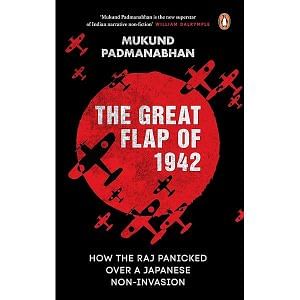So how many people fled Madras? Pre-exodus, the city’s population was around 8,00,000. There was no overall official estimate of how many people fled between December 1941 and April 1943.
According to Chief Secretary Ramamurthy, 30 per cent of the population (2,40,000 people) left Madras by mid-February 1942. He also noted that in the seven tumultuous days between the air raid alarm and the end of 14 April, another 2,00,000 people fled. (Interestingly, The Hindu reported that 3,00,000 left the city during the same period.)
Together, the two government estimates suggest there was an exodus of 4,40,000 people (or 55 per cent of the population).
This is, of course, a gross underestimate for at least three reasons. First, by the government’s own admission, there was a constant stream of people moving to the interior between February and April. Second, it was probably in the government’s interest to play down the number of people who left Madras. And finally, 55 per cent is much smaller than a raft of other assessments about how many who took flight.
According to the Indian Express, Madras’ population was reduced to about 25 per cent. This was exactly in line with the estimate of Rao Bahadur C. Tadulinga Mudaliar who said, just before becoming the city’s Mayor, that a total of 75 per cent of the population had fled—a figure reaffirmed by another councillor. C.R. Srinivasan, Editor of the venerable Swadesamitran, among the oldest vernacular newspapers in the country, estimated that five-sixths of the population (over 83 per cent) had left. But even this was smaller than the number ICS officer Paul M. Jayarajan threw up. In his reckoning, 7 lakh (7,00,000) out of the city’s population of 8,00,000 took flight—a staggering 87.5 per cent!33
While this figure may seem incredible, it is far from implausible. Those mandated to stay under the Essential Services (Maintenance) Ordinance issued in late 1941 were people working in specific sectors such as water supply, sanitary services, oil companies, banks and bus services. The others, presumably the non-essentials, made up almost the entire population. Of course, in Madras, from where most of the government dispersed, it raised the obvious but ironic question—did the government regard itself as non-essential?
Moreover, the exodus had its own internal dynamic—the more people left, the more people had to go. The shortage of such things as labour and household help was one thing. But by April, the provision shops had shuttered, the restaurants were closed and there was an acute shortage of food—a situation that left people with no option but to depart. For instance, the family of Radha Padmanabhan (née Prabhu) made the decision to up and go when the milkman stopped coming. ‘He probably fled like so many others. That was the day my father declared, “It’s time to pack up”.
Departures were hasty and unplanned. ‘Everyone was prepared to put up with any difficulty to reach a safe place,’ observed the author Pudhumaipithan. ‘Bullock carts carried children, the old, the sick, utensils, almost everything from one place to another.’ Those who had motor vehicles overtook the rows of bullock carts ‘like opportunists in politics’. Technically, the government’s April communiqué only advised people to leave, allowing it to maintain the pretence that the evacuation was entirely ‘voluntary’. But the sequence of messages about the threats seemed calculated to make people flee.
A letter to the Editor of the Mail written by an ‘Unwilling Voluntary Evacuee’ described this aptly: ‘This [April] communiqué is the culmination of a series of communiqués all of which, I have been noticing, have had the tendency to scare the people unnecessarily and make them run away.’ Swadesamitran’s Editor Srinivasan accused ‘a panicky government’ of driving people out, including presidents of town protection councils (Oorkappu Sangams) who had pledged to remain in the city. Radha Krishnamurthy’s account of her family’s departure from Madras suggests some arms of the government went well beyond advising evacuation. As a twelve-year-old, she was in school when many parents, including her mother, rushed in before noon on a date she cannot exactly recall.
‘There were policemen in cars screaming on the road, asking people to quit Madras and go to their native places. We packed in a hurry taking only clothes and valuables and took a train south from Egmore.’ The family stayed in Lalgudi, where they rented a house for about five months before returning to Chennai.
When Wadsworth came back from his relaxing break in Horsley Hills, Madras presented itself as a hollow shell, a ‘dismal spectacle’. The shops were shut; almost all private homes and offices were vacant. ‘The streets were empty and except for the police, the A.R.P. and the troops who were now arriving in considerable numbers, the place seemed dead.’ By the time Wadsworth returned to work after the court vacations, Madras was ‘bristling with guns’. The Marina—said to be the world’s second-longest urban beach—sported a shoreline garlanded with barbed wire (presumably to retard an invasion via the sea) and a ‘large dummy fort’ (doubtlessly to scare Jap bombers). The Marina was also ‘defended’ with felled palm trees. Painted black, they were placed horizontally and vertically to fool Japanese pilots into thinking they were anti-aircraft guns.
 This excerpt from ‘The Great Flap of 1942: How the Raj Panicked Over a Japanese Non-Invasion’ has been published with permission from Penguin Random House India.
This excerpt from ‘The Great Flap of 1942: How the Raj Panicked Over a Japanese Non-Invasion’ has been published with permission from Penguin Random House India.

